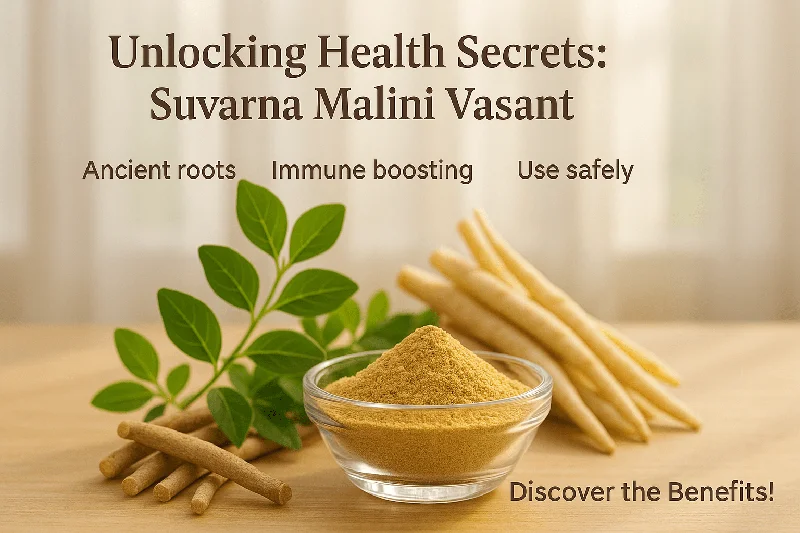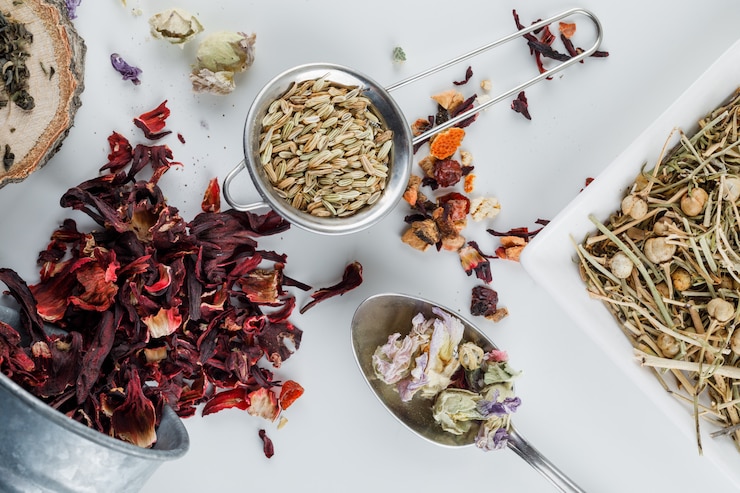Ask Ayurvedic doctor a question and get a consultation online on the problem of your concern in a free or paid mode. More than 2,000 experienced doctors work and wait for your questions on our site and help users to solve their health problems every day.
Shop Now in Our Store
Suvarna Malini Vasant: Comprehensive Overview for Better Health

Suvarna Malini Vasant has increasingly become a subject of interest among those seeking integrative approaches to health. With its roots in Ayurveda—an ancient holistic system from India—this herbal-mineral preparation is touted for multiple potential benefits, including immune support, enhanced vitality, and better overall well-being. Yet, as with any health-related product, it is essential to examine the facts, historical context, scientific research, and expert guidelines to gain a balanced understanding. In this article, we will explore how Suvarna Malini Vasant is traditionally formulated, what current research suggests, how to use it responsibly, and the precautions one should consider. By the end, you’ll have a clear sense of this formulation’s historical significance, its proposed mechanisms of action, and the scientific evidence—or lack thereof—surrounding its use.
1. Introduction: Why Suvarna Malini Vasant Matters
Suvarna Malini Vasant is often positioned as a premier “rasayana” (rejuvenator) in Ayurveda, which prides itself on optimizing health by balancing the body’s natural energies—commonly referred to as doshas. Rasayanas are specially formulated to support longevity, boost immunity, and promote mental clarity. While some people encounter Suvarna Malini Vasant through anecdotal success stories, others learn about it from wellness blogs or integrative health practitioners. With the global surge in interest in alternative and complementary medicine, understanding formulations like Suvarna Malini Vasant has become a key focus for both consumers and researchers. A 2019 survey published by the National Center for Complementary and Integrative Health revealed that nearly 30% of adults in the United States use some form of complementary approach, ranging from yoga and meditation to herbal supplements. This uptick in popularity has made it essential to scrutinize traditional Ayurvedic products under modern scientific standards. Suvarna Malini Vasant, said to contain gold bhasma and a blend of potent herbs, is no exception.
2. Historical Background and Ayurvedic Perspective
Ayurveda, often translated as the “Science of Life,” dates back over 3,000 years, with classical texts like the Charaka Samhita, Sushruta Samhita, and Ashtanga Hridaya explaining various methodologies to preserve health and treat diseases. Among these texts, rasayana therapy holds a significant place due to its promise of rejuvenation and overall vitality. Suvarna Malini Vasant specifically derives its name from two concepts: “Suvarna” (referring to gold) and “Malini Vasant,” which is linked to spring (the Vasant season in India) and renewal. Traditional Ayurvedic practitioners have long emphasized the unique combination of gold bhasma and select herbs in Suvarna Malini Vasant, claiming these ingredients work synergistically to optimize bodily functions. Gold is often described in Ayurvedic literature as “Swarna” and is believed to possess immunomodulatory benefits when properly purified and processed. Over centuries, the knowledge of creating metallic bhasmas (ashes) evolved. Alchemic texts like Rasaratna Samuccaya detail intricate purification steps, including multiple rounds of heating, cooling, and grinding with herbal juices to remove toxic elements. Such processes aim to transform heavy metals into therapeutically active but supposedly safe forms.

3. Key Ingredients: How They May Work
Suvarna Malini Vasant typically comprises a blend of herbs, minerals, and the crucial element of gold bhasma. Although specific recipes can vary based on the lineage of Ayurvedic practitioners or different pharmacopeial standards, certain common components stand out:
-
Gold Bhasma (Swarna Bhasma): Derived from pure gold subjected to repeated purification processes, gold bhasma is cited in classical Ayurvedic texts for its potential to boost immunity, support longevity, and improve vitality. Modern preliminary studies on animal models suggest that gold nanoparticles might have immunomodulatory and antioxidant properties, although large-scale human trials remain scarce.
-
Herbal Adaptogens: Many Suvarna Malini Vasant formulations include herbs known for their adaptogenic qualities, such as Ashwagandha (Withania somnifera), Shatavari (Asparagus racemosus), or even Pippali (Piper longum). Adaptogens are believed to help the body cope with stress, maintain hormonal balance, and improve resilience.
-
Synergistic Components: Some recipes include resins like Guggulu (Commiphora wightii) or other minerals that are believed to complement gold bhasma. These components aim to further enhance the formulation’s bioavailability and metabolic benefits.
Proposed Mechanisms
From an Ayurvedic viewpoint, the synergy of gold bhasma and herbal adaptogens helps balance all three doshas (Vata, Pitta, and Kapha), reinforcing the immune system while nourishing body tissues. Modern science takes a more molecular approach, hypothesizing that the active compounds may exhibit antioxidant capabilities, modulate cytokine levels in the immune system, and support stress response pathways in the body. However, the precise interactions between each ingredient remain a topic of ongoing research.
4. Scientific Evidence and Clinical Insights
While Ayurvedic practitioners have extolled the virtues of Suvarna Malini Vasant for centuries, modern scientific validation is still evolving. Below is a rundown of where the research stands today:
4.1 Potential Benefits
-
Immune Support: A 2021 review in the Journal of Ayurveda and Integrative Medicine (PubMed link placeholder) highlighted studies on gold-based Ayurvedic formulations, noting improvements in immune markers like immunoglobulins and T-cell counts in animal studies. Still, human clinical trials are needed to confirm efficacy and safety.
-
Respiratory Health: Some practitioners recommend Suvarna Malini Vasant during seasonal transitions, especially spring, which aligns with the “Vasant” concept in Ayurveda. A small observational study suggested that patients using gold-herb formulas reported fewer respiratory issues, though sample sizes were too limited for definitive conclusions.
-
Physical Stamina and Energy: Anecdotal accounts frequently mention reduced fatigue and improved endurance. In one pilot study published in the International Journal of Research in Ayurveda and Pharmacy, older adults taking a similar formulation reported better energy levels. However, placebo-controlled studies are necessary to substantiate these findings.
-
Mental Clarity and Stress Reduction: The presence of adaptogenic herbs like Ashwagandha may contribute to reduced cortisol levels and improved stress management, though it is difficult to isolate Suvarna Malini Vasant’s specific role without larger, more controlled trials.
4.2 Considerations and Safety
Despite promising leads, there are critical safety concerns to address:
-
Heavy Metal Contamination: If bhasma is not prepared correctly, harmful residues of metals like lead or mercury may remain. The World Health Organization (WHO) and various government bodies have cautioned consumers about unregulated Ayurvedic preparations. Always purchase from reputable manufacturers who follow Good Manufacturing Practices (GMP).
-
Allergic Reactions: Like any herbal supplement, ingredients may trigger allergic responses. Individuals with known sensitivities to certain herbs or metals should exercise caution.
-
Drug Interactions: Those on medications for diabetes, blood pressure, or autoimmune conditions should consult a qualified healthcare practitioner before starting Suvarna Malini Vasant, as it may interact with conventional drugs.
-
Regulatory Gaps: In many countries, Ayurvedic supplements are not evaluated as rigorously as prescription medications. This can lead to variable quality, inconsistent labeling, and difficulty verifying the authenticity of the product.
5. Practical Tips for Usage
If you and your healthcare provider decide to explore Suvarna Malini Vasant as part of your wellness routine, consider these practical guidelines:
-
Seek Professional Advice: Ayurvedic practitioners customize doses based on individual constitution (prakriti), current health conditions, and lifestyle. A typical dosage might range from 125 mg to 250 mg once or twice a day, often consumed with honey or milk.
-
Adjuvants (Anupan): Many Ayurvedic formulations recommend specific “anupans,” or carriers, that may enhance absorption or balance the formulation’s effects. For example, warm milk, ghee, or honey might be suggested depending on the body’s needs.
-
Dietary Considerations: Ayurveda places immense importance on diet. Cutting down on processed foods, adding more fresh fruits and vegetables, and eating in sync with seasonal changes can amplify the potential benefits of Suvarna Malini Vasant.
-
Lifestyle Integration: Combine your supplement regimen with balanced sleep, stress management practices like meditation or yoga, and moderate physical activity. These elements work together to support holistic well-being.
-
Monitoring and Follow-Up: Regular check-ups with your healthcare provider are crucial. Blood tests and other diagnostic measures may help you track how your body responds over time, ensuring you catch any adverse reactions or interactions early.
6. Frequently Asked Questions (FAQ)
Q1: Can Suvarna Malini Vasant cure specific diseases like diabetes or arthritis?
A: No. Ayurveda generally does not advocate a single remedy for curing chronic conditions; instead, it promotes a holistic approach. Suvarna Malini Vasant may offer supportive benefits, but it should not replace professional medical treatment. Always follow the guidance of your primary healthcare provider for disease management.
Q2: Is it safe for children?
A: Some Ayurvedic texts mention the use of gold-based formulas for children under strict supervision to support immunity. However, modern guidelines emphasize caution. If you’re considering giving Suvarna Malini Vasant to a child, seek advice from a pediatrician and an experienced Ayurvedic practitioner.
Q3: Are there any large-scale clinical trials available?
A: Currently, large-scale human trials are limited. Nonetheless, smaller studies and animal research exist, showing promising but not definitive results. Searching platforms like PubMed for “Suvarna Malini Vasant” or “gold-based Ayurvedic formulations” can provide insight into ongoing and past research.
Q4: How soon can I expect results?
A: Ayurveda generally views health improvements as gradual. Some users claim they notice better energy or immunity within weeks, while others may need several months. Factors such as dosage, lifestyle habits, and individual constitution significantly influence the timeframe.
Q5: What should I look for in product labeling?
A: Ensure the label specifies GMP certification, lists all ingredients (including the type of bhasma), and provides dosing instructions. Look for transparency about manufacturing processes. If possible, consult independent lab tests or third-party certifications.
7. Conclusion and Call to Action
Suvarna Malini Vasant is a fascinating Ayurvedic formulation that merges tradition with emerging modern interest. Its combination of gold bhasma and a variety of potent herbs underscores Ayurveda’s belief in synergy, suggesting that the whole may be greater than the sum of its parts. While historical and preliminary scientific data point to potential benefits—particularly in immune support, energy enhancement, and overall vitality—comprehensive clinical evidence remains a work in progress. If you’re contemplating adding Suvarna Malini Vasant to your healthcare plan, consult both an Ayurvedic specialist and your primary medical provider to ensure it aligns well with your individual needs and medications.
If you found this guide useful, please share it with your friends and family who are curious about Ayurveda or integrative medicine. Feel free to leave a comment with your questions or experiences. We also invite you to subscribe to our newsletter for the latest articles covering evidence-based approaches to traditional remedies, general wellness, and more. Your participation not only helps us grow but also fosters a community of informed readers interested in holistic health.
Disclaimer
This article is for informational purposes only and is not intended as medical advice. Statements about Suvarna Malini Vasant have not been evaluated by the U.S. Food and Drug Administration or other regulatory bodies. Always consult a qualified healthcare professional before making any changes to your supplement regimen, particularly if you have pre-existing conditions or are taking medications. Individual results may vary, and what works for one person may not be appropriate for another. Use this information at your own discretion, and remember that holistic health includes regular medical check-ups, balanced nutrition, and an overall healthy lifestyle.
By understanding its traditional underpinnings, modern research, and best usage practices, you can make an informed decision about Suvarna Malini Vasant. Remember, the journey towards well-being often involves a blend of age-old wisdom and contemporary scientific validation. Stay curious, stay cautious, and stay open to a holistic perspective on health.
This article is checked by the current qualified Dr. Harsha Joy and can be considered a reliable source of information for users of the site.


